Numerical Analysis of the Effect of Groundwater Seepage on the Active Freezing and Forced Thawing Temperature Fields of a New Tube–Screen Freezing Method
Abstract
:1. Introduction
2. Coupling Theory
2.1. Temperature Field
2.2. Seepage Field
2.3. Coupling of Temperature and Percolation Fields
3. Project Overview and Numerical Modeling
3.1. Project Overview
3.2. Construction of the Numerical Model
3.3. Basic Assumptions for Numerical Calculation
- The most unfavorable soil parameters are selected for simulation, assuming that the area of freezing is saturated soil, and the soil is continuous, uniform, and isotropic;
- The brine temperature is always considered to be the temperature of the outer wall of the frozen pipe, ignoring the heat loss caused by convective heat transfer of brine;
- The seepage field within the frozen area conforms to Darcy’s law, and the seepage velocity approaches zero after the soil freezes;
- The effect of the stress field on the temperature field is neglected, considering only the coupling effect of the temperature field and seepage field;
- According to the project profile, it is assumed that the formation of permafrost curtain starts at −1 °C, and that the formation of permafrost curtain in the area within the −13 °C isotherm meets the excavation conditions;
- There is no freezing deflection of the frozen pipe during the freezing process of the model, along with uniform unidirectional seepage of water flow, and no heat loss during the freezing process.
3.4. Parameter Selection
3.5. Initial and Boundary Conditions
3.5.1. Initial Conditions
3.5.2. Boundary Conditions
3.6. Path Setting
4. Analysis of Calculation Results
4.1. Analysis of Freezing Temperature Field
4.2. Analysis of Forced Thawing Temperature Field
4.2.1. Development of Forced Thaw Temperature Field
4.2.2. Comparison of Different Thawing Solutions
5. Conclusions
- During the active freezing period, the frozen curtain formed by the same row of frozen pipes started to cross circles after 2 days of freezing, the frozen curtain formed by different rows of frozen pipes started to cross circles after 4 days of freezing, and a more complete frozen wall started to form after 6 days of freezing, at which time the development of the frozen curtain was not significantly affected by the seepage. The frozen curtain formed after 30 days of freezing met the construction requirements. To ensure safe construction, the curtain must be maintained frozen; hence, it needs to freeze 40 days before construction can be carried out.
- During active freezing, the seepage action has a greater impact on the development of the permafrost curtain. The seepage action carries the cold energy generated by the upstream freezing tube to the downstream; therefore, there is a phenomenon of thin permafrost curtain upstream and thick permafrost curtain downstream, which becomes more evident with the increase in seepage velocity.
- During the forced thawing process, larger heads of water lead to a more obvious change in time required to raise the thawing temperature to completely thaw. For example, when the head difference was 3 m, it took 82 days to completely thaw at a thawing temperature of 5 °C, and only 31 days to completely thaw at a thawing temperature of 50 °C; when the head difference was 1 m, it took 39 days to completely thaw at a thawing temperature of 5 °C, and 20 days to completely thaw at a thawing temperature of 50 °C.
- The thawing effect is good at the beginning of thawing with the high warming rate of permafrost curtain, whereby about 90% of the permafrost curtain could be thawed in 15 days, and the temperature change of permafrost curtain tended to be flat after 15 days. The study of different heads of water and different forced thawing temperatures found that larger heads of water resulted in a longer thawing time. At the same thawing temperature, the thawing time for a 3 m head of water was about two times that for a 1 m head of water is 1 m. A higher thawing temperature resulted in a shorter the thawing time. At the same head of water, the thawing time at a temperature of 50 °C was about 0.5 times that at a temperature of 5 °C.
- The new tube–curtain freezing method is suitable for the construction of the estuary channel; due to the special nature of its freezing tube and steel pipe arrangement, a permafrost curtain with good waterproofing and high strength can be formed by actively freezing for 40 days, providing security for construction excavation. Jacking into the steel pipe can avoid the problem of thawing soil subsidence of the frozen curtain at the end of construction. Due to the large volume of the formed frozen curtain, in order to accelerate the construction progress, forced thawing of the frozen curtain can be performed by sending high-temperature brine to the frozen pipes to speed up the thawing of the frozen curtain.
- The use of the freezing method for underground construction is more environmentally friendly, with no pollution to the surrounding environment, no foreign substances into the soil, and less noise. Furthermore, the freezing curtain will melt away after the freezing is over, without affecting the underground structure around the building. Conveniently, it can effectively shorten the construction period, thus reducing the construction cost. It is highly adaptable and can be used for reinforcement of any water-bearing strata under various complex geological and hydrogeological conditions, and it is basically independent of the form, plan size, and depth of the pit. Its application is in line with the concept of sustainable development.
Author Contributions
Funding
Institutional Review Board Statement
Informed Consent Statement
Data Availability Statement
Conflicts of Interest
References
- Zhang, C.; Yang, W.H.; Qi, J.G. Analytic computation on the forcible thawing temperature field formed b-y a single heat transfer pipe with unsteady outer surface temperature. J. Coal Sci. Eng. 2015, 18, 8–24. [Google Scholar]
- Ma, W. Review and prospect of the studies of ground freezing technology in China. J. Glaciol. Geocryol. 2001, 23, 218–224. [Google Scholar]
- Yue, F.T.; Qiu, P.Y.; Yang, G.X. Numerical calculation of the freezing method for the contact channel of the cross-river tunnel. J. Coal 2005, 30, 710–714. [Google Scholar]
- Hu, K.; Zhou, G.Q.; Li, X.J. Law of Soil Frost Expansion under Different Constraints. Int. J. Coal Geol. 2011, 36, 1653–1658. [Google Scholar]
- Andersland, O.B.; Ladanyi, B. Frozen Ground Engineering; Wiley: Hoboken, NJ, USA, 2004. [Google Scholar]
- Li, W.Q. Research and Application of Tube Curtain Method in Environmental Protection. Int. J. Constr. Constr. 2003, 33, 229–231. [Google Scholar]
- Huang, F.; Shi, R.J.; Yue, F.T. Model Test of the Boundary Development Process of the Frozen Wall of Steel Tube Permafrost Co-Structure. J. Rock Mech. Eng. 2022, 41, 3063–3072. [Google Scholar]
- Yuan, Y.H.; Yang, P. Application of Artificial Freezing Technology in Mine Tunnel. J. Railw. Eng. 2016, 33, 82–86+103. [Google Scholar]
- Wang, L.; Chen, X.S.; Wu, J. Experimental study on the freezing law model of large underground space pipe curtain in urban water-rich strata. Tunn. Constr. Chin. Engl. 2022, 42, 1871–1878. [Google Scholar]
- Liu, J.; Ma, B.; Cheng, Y. Design of the Gongbei tunnel using a very large cross-section pipe-roof and soil freezing method. Tunn. Undergr. Space Technol. 2018, 72, 28–40. [Google Scholar] [CrossRef]
- Zhou, X.; Pan, J.; Liu, Y. Analysis of Ground Movement during Large-Scale Pipe Roof Installation and Artificial Ground Freezing of Gongbei Tunnel. Adv. Civ. Eng. 2021, 2021, 8891600. [Google Scholar] [CrossRef]
- Hu, X.; Deng, S.; Ren, H. In situ test study on freezing scheme of freeze-sealing pipe roof applied to the Gongbei tunnel in the Hong Kong-Zhuhai-Macau bridge. J. Appl. Sci. 2016, 7, 27. [Google Scholar] [CrossRef] [Green Version]
- Duan, Y.R.; Cheng, C.H. Experimental and Numerical Investigation on Improved Design f-or Profiled Freezing-tube of FSPR. Processes 2020, 8, 992. [Google Scholar] [CrossRef]
- Zhang, P.; Ma, B.S.; Zeng, C. Key techniques for the largest curved pipe jacking roof to date: A case study of Gongbei tunnel. Tunn. Undergr. Space Technol. 2016, 59, 134–145. [Google Scholar] [CrossRef]
- Kang, Y.S.; Liu, Q.S.; Cheng, Y. Combined freeze-sealing and New Tubular Roof construction methods for seaside urban tunnel in soft ground. Tunn. Undergr. Space Technol. 2016, 58, 1–10. [Google Scholar]
- Duan, Y.; Rong, C.X.; Cai, H.B. Experimental Study on Mechanical Properties of “Top Tube-Permafrost” Composite Structure in Tube-screen Frozen Tunnel. Geol. Explor. Coal Fields 2022, 1–12. [Google Scholar]
- Duan, Y.; Rong, C.; Cheng, H. Freezing Temperature Field of FSPR under Different Pipe Configurations: A Case Study in Gongbei Tunnel, China. Adv. Civ. Eng. 2021, 2021, 9958165. [Google Scholar]
- Zhang, P.; Xu, P.; Yao, Q.; Zhang, Y.M.; Wang, T.; Zheng, Y.X. Construction technology of new pipe curtain method for subway stations with soft water-rich strata. Constr. Technol. Chin. Engl. 2022, 51, 35–39+53. [Google Scholar]
- Zhou, W.; Hu, J.; Zeng, H.; Li, K.; Zeng, D.; Wang, Z.; Feng, J. Influence of different seepage velocities on the temperature field of the new tube screen freezing method. J. Hainan Univ. Nat. Sci. Ed. 2023, 41, 85–94. [Google Scholar] [CrossRef]
- Zhou, Y.; Hu, J.; Xiong, H.; Ren, J.; Zhan, J.; Wang, Z. Temperature field analysis of the new pipe curtain freezing method in riverbank seepage control reinforcement. Coalf. Geol. Explor. 2022, 50, 110–117. [Google Scholar]
- Duan, Y. Study on the Formation Law of Freezing Temperature Field of Tunnel Pipe Curtain and Its Mechanical Characteristics; Anhui University of Technology: Anhui, China, 2021. [Google Scholar] [CrossRef]
- Duan, Y.; Rong, C.; Cheng, H.; Cai, H.; Xie, D.; Ding, Y. Model test of freezing temperature field of pipe curtain with different pipe jacking combinations. Glacial Permafr. 2020, 42, 479–490. [Google Scholar]
- Han, X.M.; Xiao, M.Q.; Li, W.J.; Zhu, Y.Q. Study on Influence of Tube Curtain-Structure Mass Pipe Overhead on Station Floor and Stock Road Settlement. Tunn. Constr. 2020, 40, 170–178. [Google Scholar]
- Zhang, S.L.; Wang, L.; He, Y.L.; Li, J.P.; Li, B. Study on Development of Freezing Temperature Field in Composite Stratigraphic Contact Channel. Undergr. Space Eng. J. 2022, 18, 266–273. [Google Scholar]
- Li, Y.P. Characterization of Freezing Temperature Field Distribution in Combined Pipe Curtain Frozen Soil Structures; China University of Mining and Technology: Xuzhou, China, 2022. [Google Scholar] [CrossRef]
- Abdelzaher, M.A.; Shehata, N. Hydration and synergistic features of nanosilica-blended high alkaline white cement pastes composites. Appl. Nanosci. 2022, 12, 1731–1746. [Google Scholar]
- Owaid, K.A.; Hamdoon, A.A.; Matti, R.R.; Saleh, M.Y.; Abdelzaher, M.A. Waste Polymer and Lubricating Oil Used as Asphalt Rheological Modifiers. Materials 2022, 15, 3744. [Google Scholar] [CrossRef]
- Ren, J.X.; Jia, L.; Yang, J.X.; Hu, J.; Lin, X.Q.; Zeng, D.L. Numerical simulation of the effect of groundwater salinity on the freezing temperature field at the bottom of foundation pits under seepage conditions. J. Changjiang Acad. Sci. 2023, 1–11. [Google Scholar]
- Pimentel, E.; Papakonstantinou, S.; Anagnostou, G. Numerical interpretation of temperature distributions from three ground freezing applications in urban tunnelling. Turn Undergr. Space Technol. 2012, 28, 57–69. [Google Scholar] [CrossRef]
- Yao, Z.; Cai, H.; Xue, W. Numerical simulation and measurement analysis of the temperature field of artificial freezing shaft sinking in Cretaceous strata. AIP Adv. 2019, 9, 025209. [Google Scholar] [CrossRef] [Green Version]
- Zhao, Y.H.; Yang, P.; Wang, N.; Zhang, Y.W. Study on the thawing temperature field of MJS+ horizontal freezing reinforcement in the overlapping area of the underpass station. J. For. Eng. 2021, 6, 159–166. [Google Scholar]
- Yan, Q.; Wu, W.; Zhong, H.; Zhao, Z.; Zhang, C. Temporal and spatial variation of temperature and displacement fields throughout cross-passage artificial ground freezing. Cold Reg. Sci. Technol. 2023, 209, 103817. [Google Scholar]
- Qu, D.; Luo, Y.; Li, X. Study on the Stability of Rock Slope Under the Coupling of Stress Field. Seepage Field, Temperature Field and Chemical Field. Arab. J. Sci. Eng. 2020, 45, 8315–8329. [Google Scholar]
- Wang, B.; Rong, C.; Lin, J. Study on the formation law of the freezing temperature field of freezing shaft sinking under the action of large-flow-rate groundwater. Adv. Mater. Sci. Eng. 2019, 2019, 1670820. [Google Scholar] [CrossRef] [Green Version]
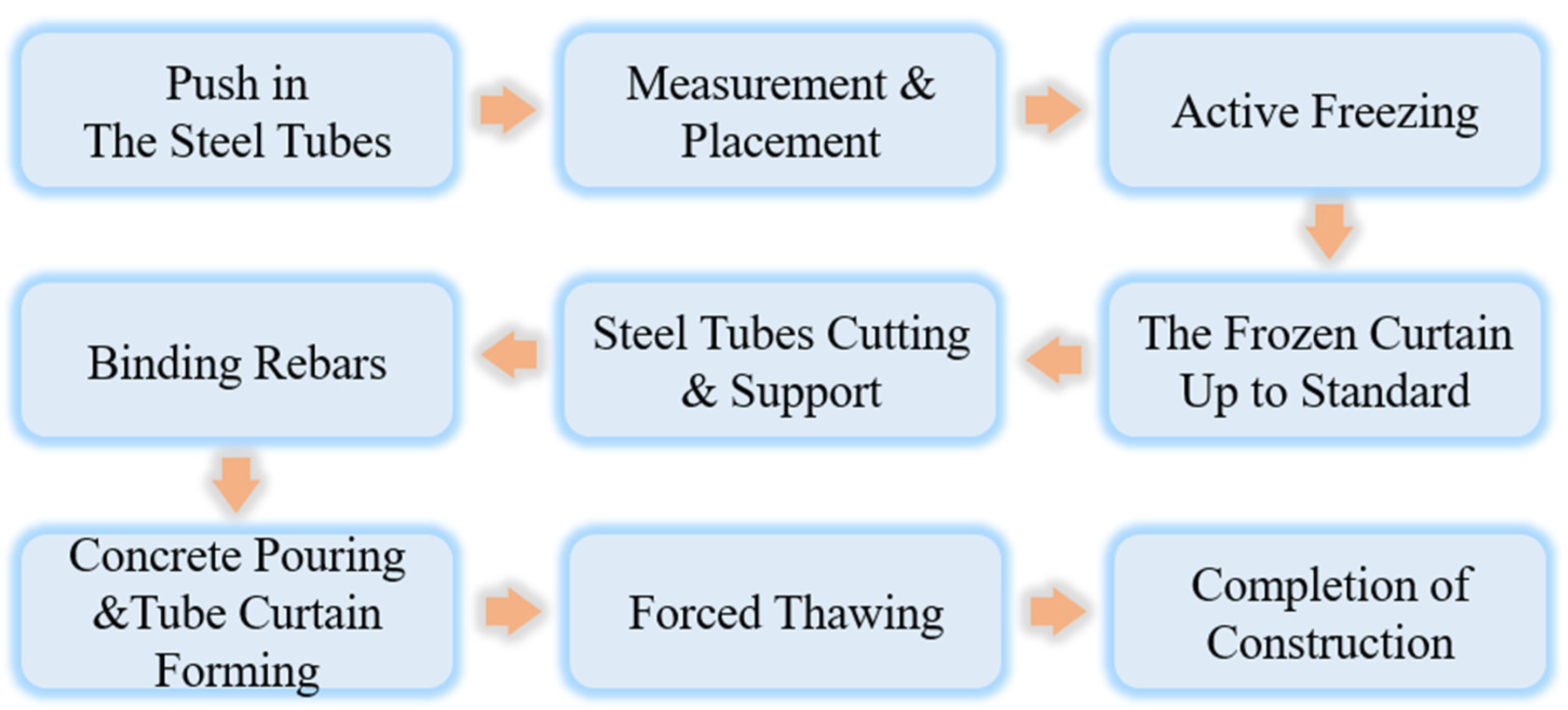
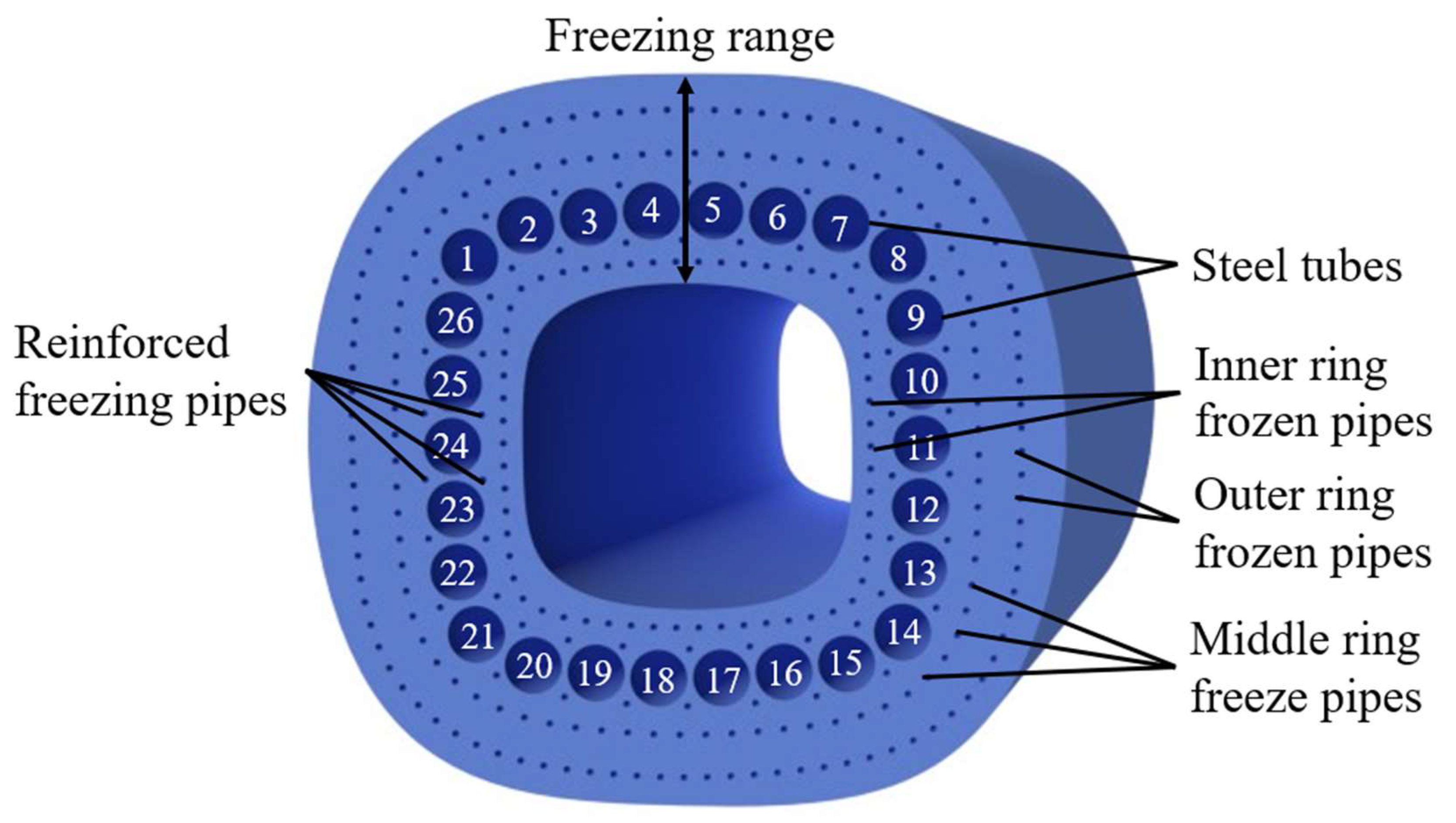


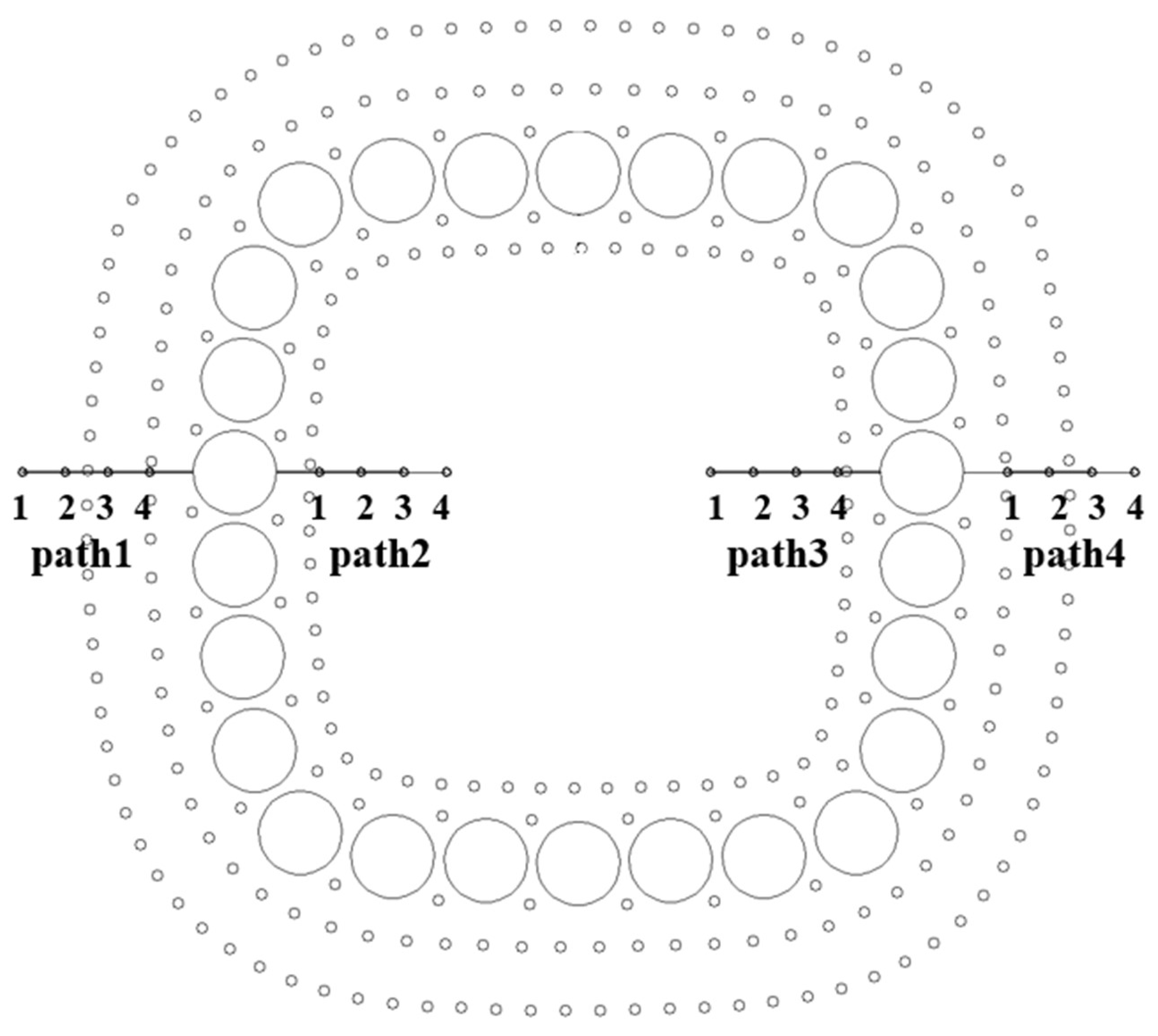

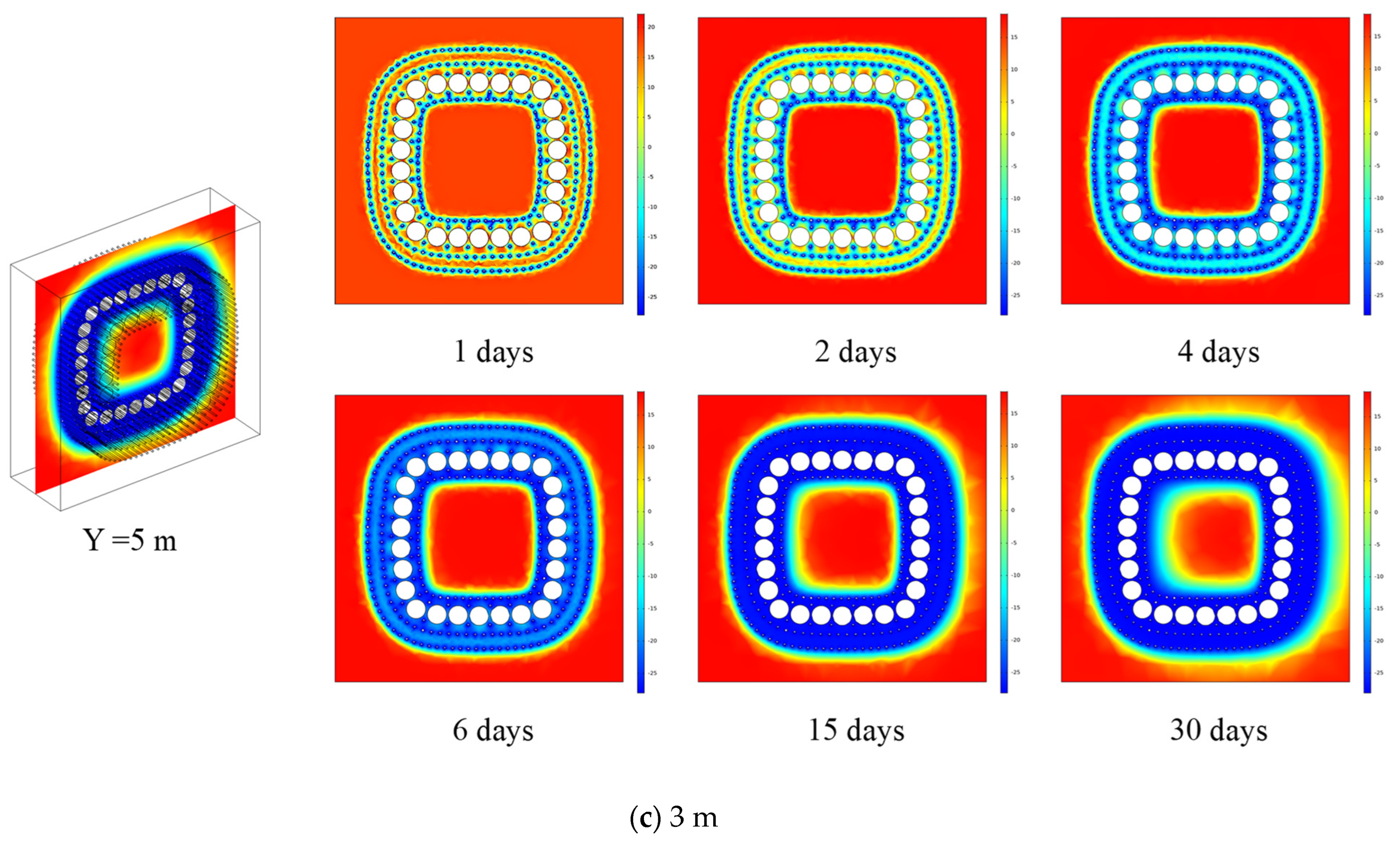


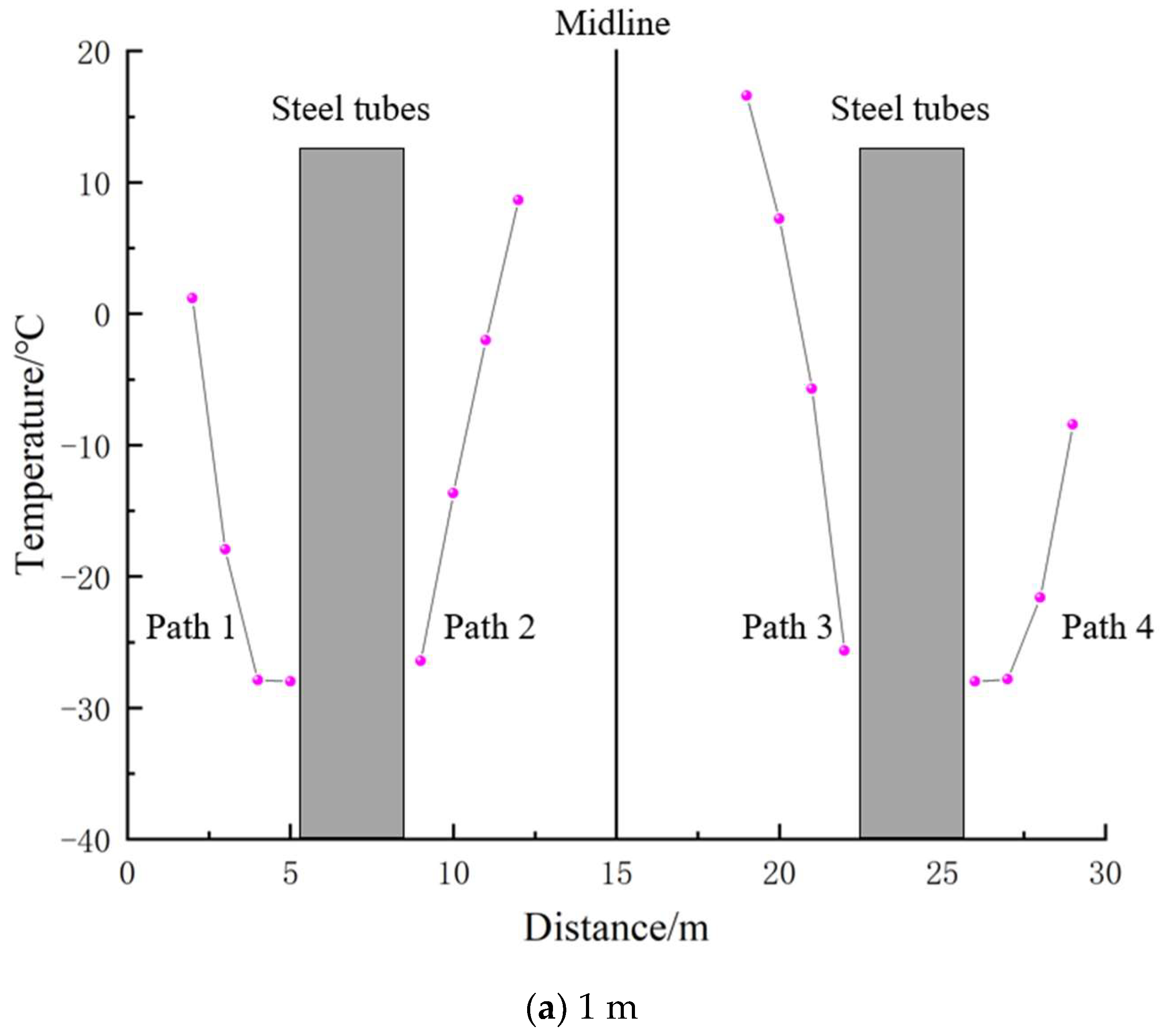
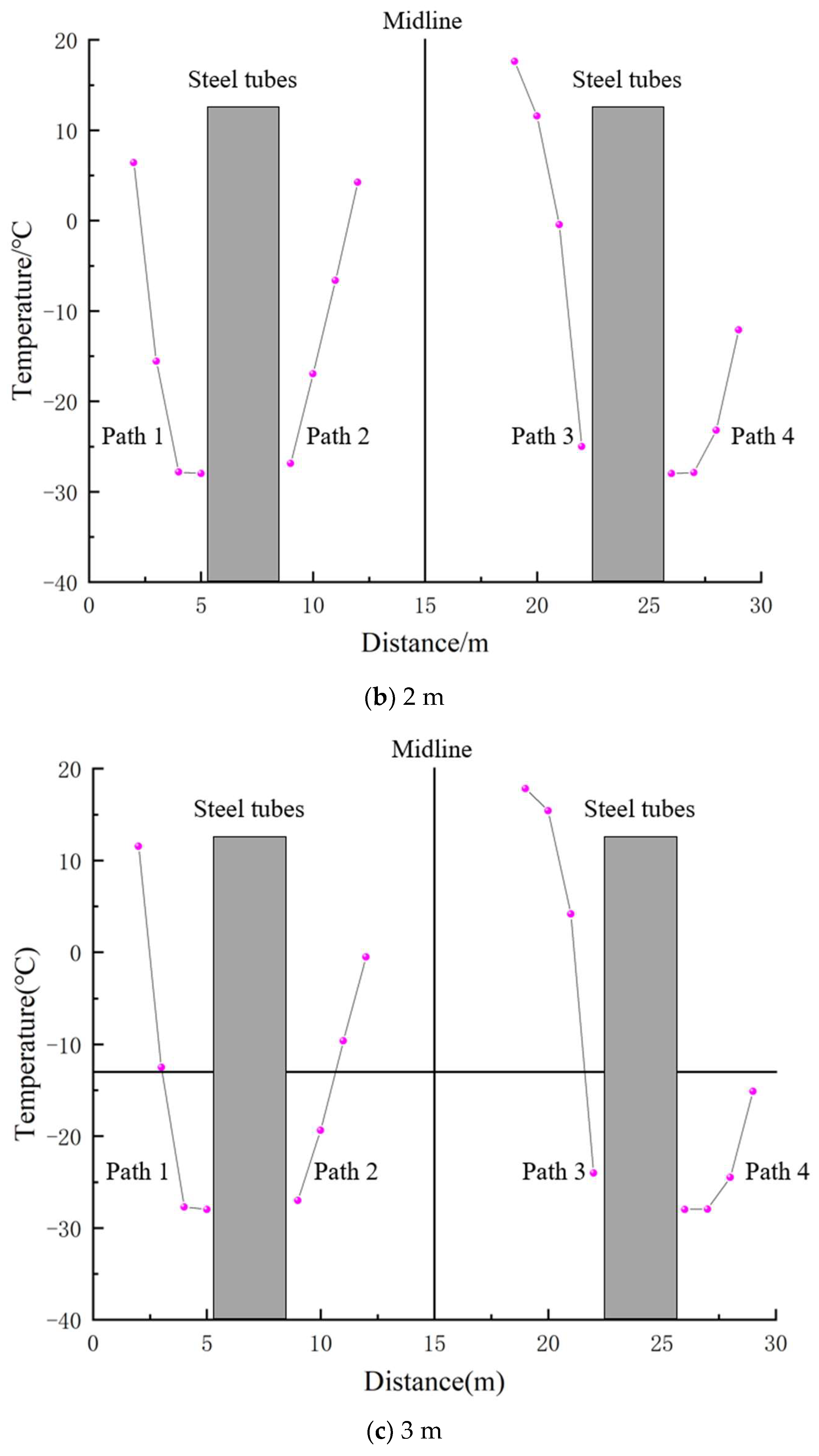
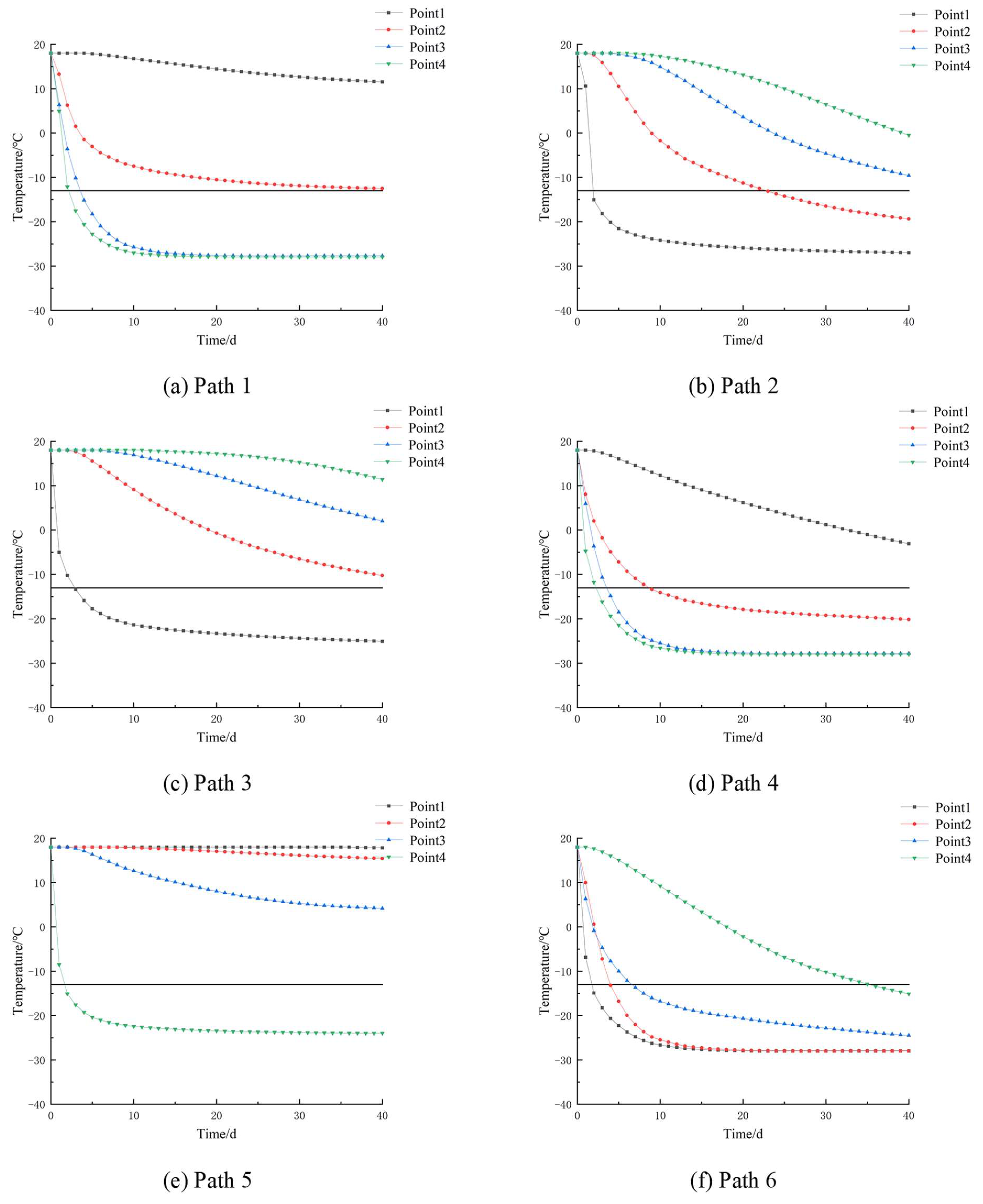
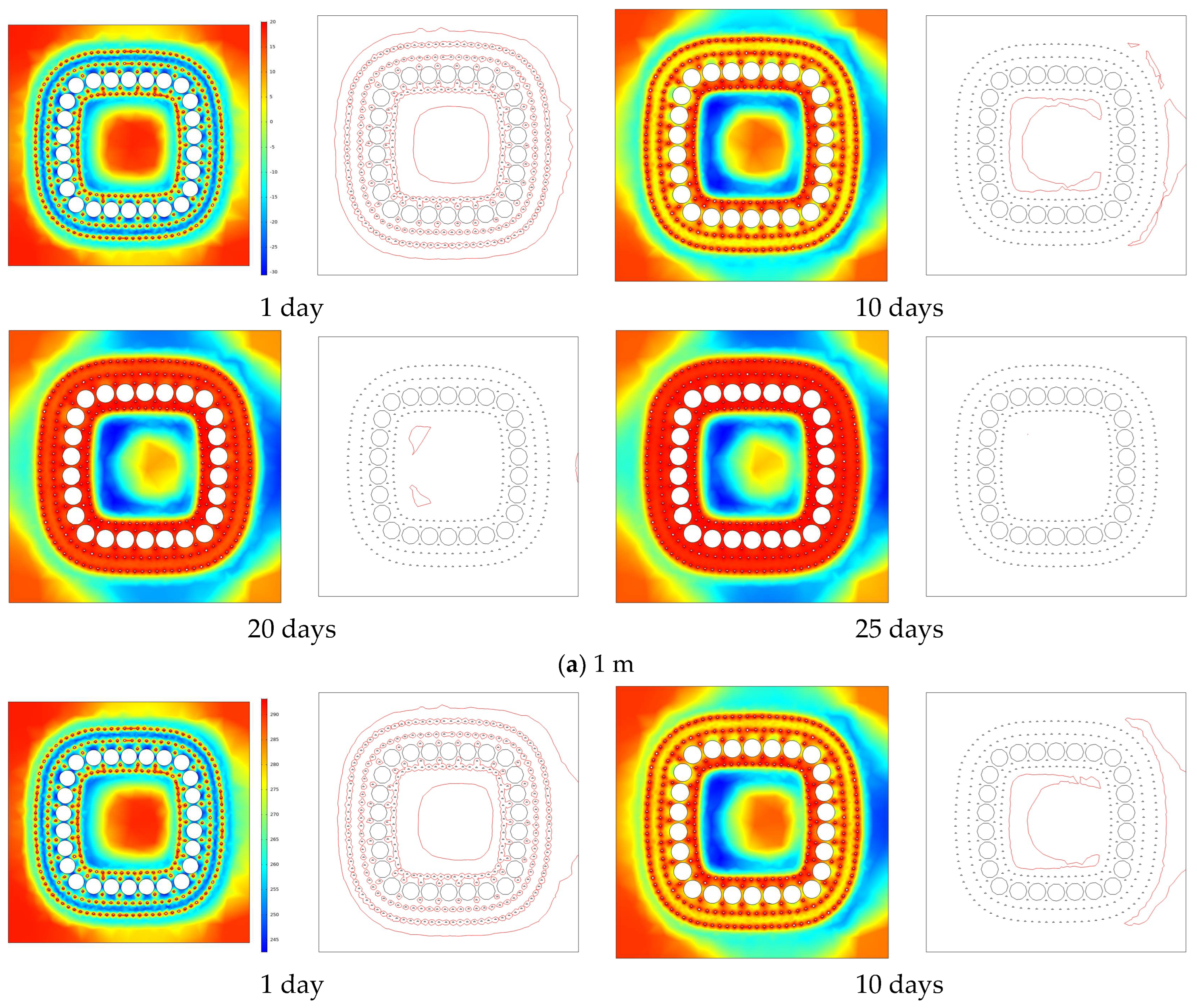
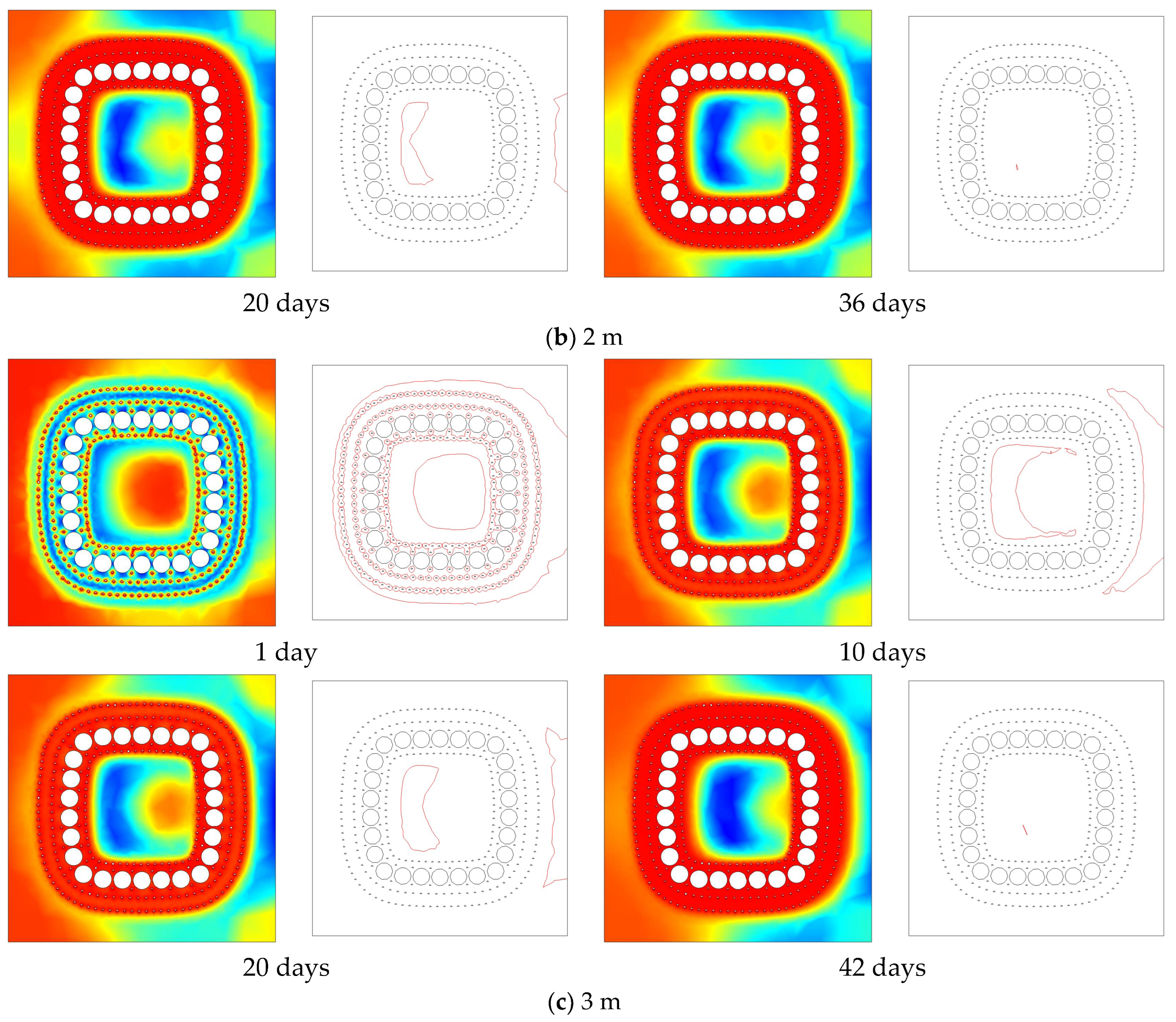
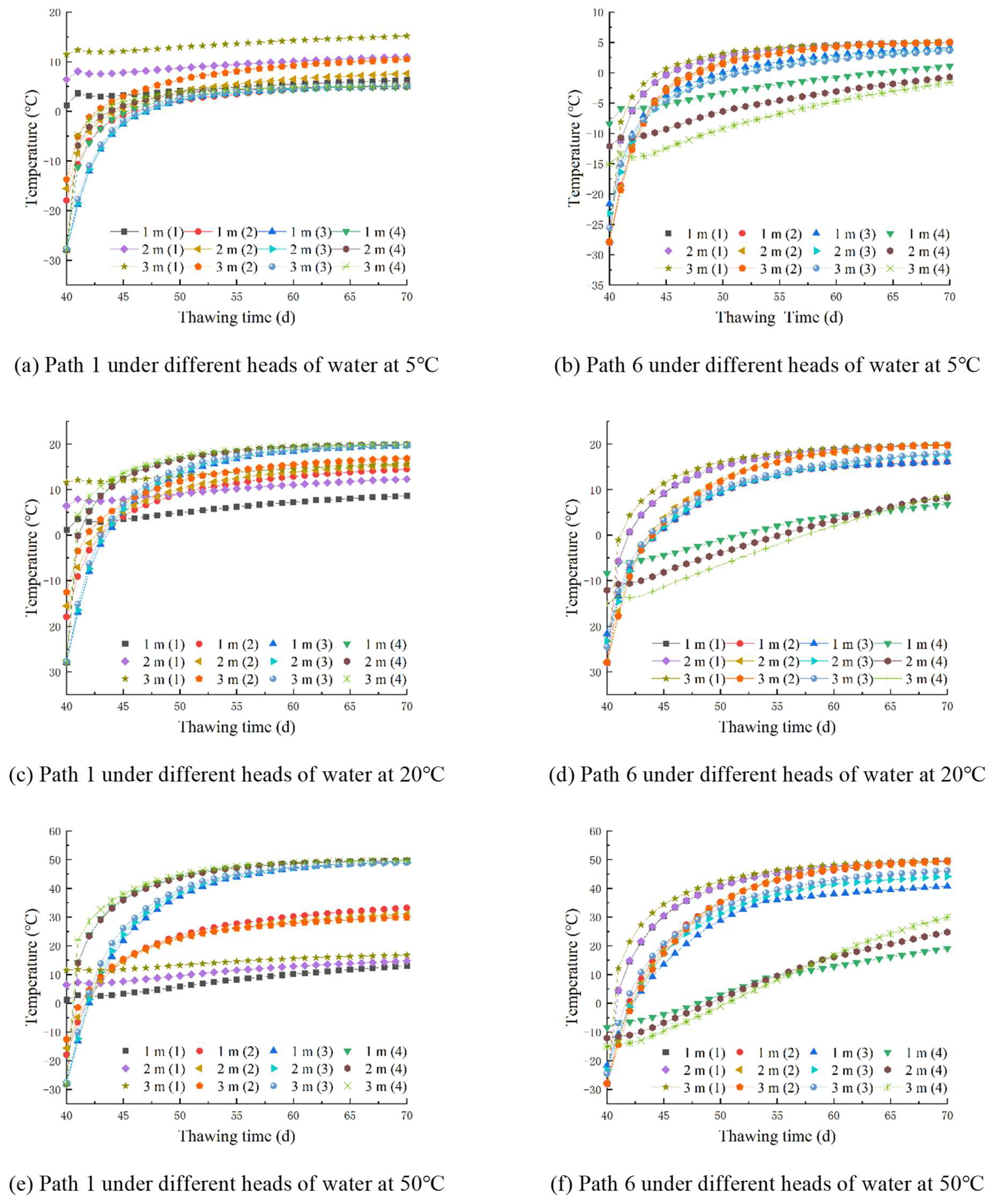
| Name of the Parameter | Value | |
|---|---|---|
| Density of water () | 1000 | |
| Density of ice () | 917 | |
| Density of soil () | Unfrozen soil | 1920 |
| Frozen soil | 1895 | |
| Thermal conductivity of water | 0.63 | |
| Thermal conductivity of ice | 2.31 | |
| Thermal conductivity of soil | Unfrozen soil | 1.72 |
| Frozen soil | 1.96 | |
| Specific heat of water | 4180 | |
| Specific heat of ice | 2050 | |
| Specific heat of the soil | Unfrozen soil | 1690 |
| Frozen soil | 1690 | |
| Soil permeability coefficient | Unfrozen soil | 1.91 |
| Frozen soil | 1.16 |
| Time (Day) | 0 | 1 | 5 | 10 | 15 | 20 | 30 | 40 |
| Temperature (°C) | 18 | 0 | −20 | −25 | −28 | −28 | −28 | −28 |
| Thawing Program | 1 | 2 | 3 |
| Thawing Temperature | 5 °C | 20 °C | 50 °C |
| Temperature | 5 °C | 20 °C | 50 °C | ||
|---|---|---|---|---|---|
| Time (Days) | |||||
| Heads of Water | |||||
| 1 m | 39 | 25 | 20 | ||
| 2 m | 61 | 37 | 27 | ||
| 3 m | 82 | 42 | 31 | ||
Disclaimer/Publisher’s Note: The statements, opinions and data contained in all publications are solely those of the individual author(s) and contributor(s) and not of MDPI and/or the editor(s). MDPI and/or the editor(s) disclaim responsibility for any injury to people or property resulting from any ideas, methods, instructions or products referred to in the content. |
© 2023 by the authors. Licensee MDPI, Basel, Switzerland. This article is an open access article distributed under the terms and conditions of the Creative Commons Attribution (CC BY) license (https://creativecommons.org/licenses/by/4.0/).
Share and Cite
Ren, J.; Wang, Y.; Wang, T.; Hu, J.; Wei, K.; Guo, Y. Numerical Analysis of the Effect of Groundwater Seepage on the Active Freezing and Forced Thawing Temperature Fields of a New Tube–Screen Freezing Method. Sustainability 2023, 15, 9367. https://doi.org/10.3390/su15129367
Ren J, Wang Y, Wang T, Hu J, Wei K, Guo Y. Numerical Analysis of the Effect of Groundwater Seepage on the Active Freezing and Forced Thawing Temperature Fields of a New Tube–Screen Freezing Method. Sustainability. 2023; 15(12):9367. https://doi.org/10.3390/su15129367
Chicago/Turabian StyleRen, Jixun, Yongwei Wang, Tao Wang, Jun Hu, Kai Wei, and Yanshao Guo. 2023. "Numerical Analysis of the Effect of Groundwater Seepage on the Active Freezing and Forced Thawing Temperature Fields of a New Tube–Screen Freezing Method" Sustainability 15, no. 12: 9367. https://doi.org/10.3390/su15129367





